
The Siberian rubythroat is a small passerine bird first described by Peter Simon Pallas in 1776. It was formerly classed as a member of the thrush family, Turdidae, but is now more generally considered to be an Old World flycatcher of the family Muscicapidae. The Siberian rubythroat and similar small European species are often called chats.

The Ryukyu robin is a bird endemic to the Ryūkyū Islands, of Japan. The Okinawa robin previously was considered a subspecies.

The Old World flycatchers are a large family, the Muscicapidae, of small passerine birds restricted to the Old World, with the exception of several vagrants and two species, bluethroat and northern wheatear, found also in North America. These are mainly small arboreal insectivores, many of which, as the name implies, take their prey on the wing. The family is relatively large and includes 357 species, which are divided into 54 genera.

The Siberian blue robin is a small passerine bird that was formerly classified as a member of the thrush family, Turdidae, but is now more generally considered to belong to the Old World flycatcher family, Muscicapidae. It and similar small European species are often called chats. Recent research suggests that this species and some other East Asian members of Luscinia should be classified in a new genus, together with the Japanese and Ryūkyū robins. The genus name Larvivora comes from the Neo-Latin larva meaning caterpillar and -vorus meaning eating, and cyane is Latin for "dark-blue".

The Indian blue robin is a small bird found in the Indian Subcontinent. Formerly considered a thrush, it is now considered one of the Old World flycatchers in the family Muscicapidae. It was earlier also called the Indian blue chat. It is migratory, breeding in the forests along the Himalayas of Nepal, India, Myanmar and Bangladesh. They winter in the hill forests of the Western Ghats of India and in Sri Lanka.

Luscinia is a genus of smallish passerine birds, containing the nightingales and relatives. Formerly classed as members of the thrush family Turdidae, they are now considered to be Old World flycatchers (Muscicapidae) of the chat subfamily (Saxicolinae). The chats are a lineage of Old World flycatchers that has evolved convergently to thrushes.
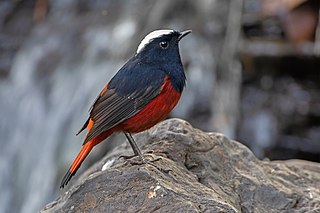
The white-capped redstart or white-capped water redstart is a passerine bird of the Old World flycatcher family Muscicapidae native to the Indian Subcontinent,Southeast Asia, much of China, and to certain regions of Central Asia.

The firethroat also known as David's rubythroat or Père David's orangethroat is a species of passerine bird in the family Muscicapidae, found in western and central parts of China. It breeds in Sichuan, China, and winters primarily in the Indian subcontinent. Its wintering range spans across Bangladesh, Bhutan, India, Nepal, Tibet and Myanmar. Its natural habitat is temperate forests. It is threatened by habitat loss.

The rufous-headed robin is a species of passerine bird in the family Muscicapidae. It is found in central China. Its natural habitats are temperate forests and temperate shrubland. This poorly known species is thought to be threatened by habitat loss.
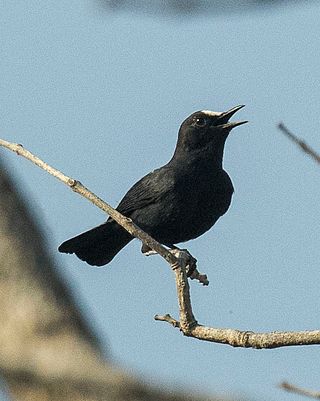
The white-fronted black chat is a species of passerine bird in the family Muscicapidae. It is native to the Sudan (region). Its natural habitats are moist savanna and subtropical or tropical dry shrubland.
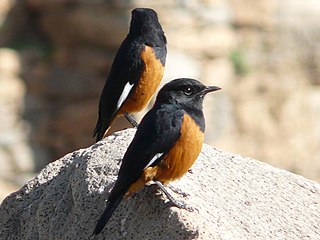
The white-winged cliff chat is a species of passerine bird in the Old World flycatcher family Muscicapidae. It is found in rocky wooded gorges, among boulders and in road cuttings within the Ethiopian Highlands.

Phoenicurus is a genus of passerine birds in the Old World flycatcher family Muscicapidae, native to Europe, Asia and Africa. They are named redstarts from their orange-red tails. They are small insectivores, the males mostly brightly coloured in various combinations of red, blue, white, and black, the females light brown with a red tail. A molecular phylogenetic study published in 2010 led to a reorganization of the Old World flycatchers family in which the two species in Rhyacornis and the single species in Chaimarrornis were merged into Phoenicurus.

Güldenstädt's redstart also sometimes called the white-winged redstart, is a species of bird in the genus Phoenicurus, family Muscicapidae. It is found in the high mountains of the southwestern and central Palearctic in the Caucasus, Karakoram, Pamir, Himalaya, Tian Shan, and Altai, in the countries of Afghanistan, Armenia, Azerbaijan, Bhutan, China, Georgia, India, Iran, Kazakhstan, Mongolia, Nepal, Pakistan, Russia, Tajikistan, Turkmenistan, and Uzbekistan.
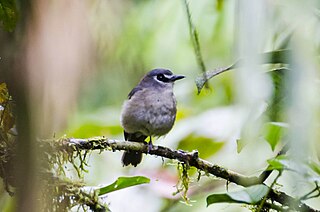
The slaty-backed jungle flycatcher, also known as the Goodfellow's jungle flycatcher or the Mindanao jungle flycatcher is a species of bird in the Old World flycatcher family Muscicapidae. It is endemic to the Philippines found only on the island of Mindanao. The specific epithet honours the British zoological collector Walter Goodfellow. Its natural habitat is tropical moist montane forests. It is threatened by habitat loss

The white-browed jungle flycatcher, also known as the Luzon jungle-flycatcher and the Rusty-flanked jungle-flycatcher, is a species of bird in the Old World flycatcher family Muscicapidae. It is endemic to Luzon island, in the Philippines. The natural habitat of the white-browed jungle flycatcher is tropical moist montane forests of the Cordillera Mountain Range and possibly Sierra Madre Mountains. It is threatened by habitat loss.

The fulvous-chested jungle flycatcher is a species of bird in the Old World flycatcher family Muscicapidae. It is found in Brunei, Indonesia, Malaysia, Myanmar, and Thailand. Its natural habitat is subtropical or tropical moist lowland forests.
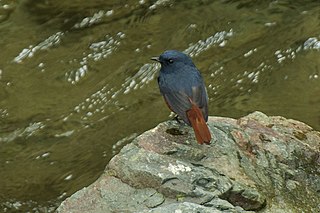
The Luzon water redstart, also known as the Luzon redstart, is a species of bird in the family Muscicapidae. It is endemic to the Philippines found primarily on Luzon with no records in Mindoro since 1965. Its natural habitats are tropical moist lowland forest, tropical moist montane forest, and rivers. It is threatened by habitat loss.

The plumbeous water redstart is a passerine bird in the Old World flycatcher family Muscicapidae. It is found in South Asia, Southeast Asia and China. Males are slate blue in colour, while females are grey. The bird's common name refers to its colour which resembles lead. They tend to live near fast-moving streams and rivers.

Larvivora is a genus of small passerine birds belonging to the Old World flycatcher family Muscicapidae that occur in central and eastern Asia.

The Chinese rubythroat is a small passerine bird in the family Muscicapidae. It is closely related to the Siberian rubythroat which however lacks the distinctive white tail-tips and white tail bases. It was also previously considered conspecific with the Himalayan rubythroat, together called the white-tailed rubythroat. It is found along the Himalayan ranges from Pakistan to Myanmar.























